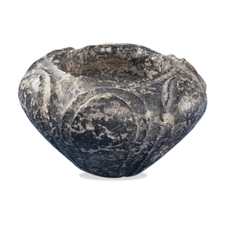Introduction

The Minoan stone vase shaped like a flower or the “blossom bowl” (Fig. 1) was produced between 1700 and 1450 BC in Crete during the Minoan era (“Stone vase shaped like a flower.”). The vessel is peculiar for the sophistication of its forms and its artful fulfillment. These characteristics are traditional for the Minoan culture largely influenced by the sublime vision of financially secure citizens inhabiting Crete those days. Overall, the evaluation of parameters of the stone vase along with its cultural significance suggests that Minoan culture is the synthesis of values promoted by the Minoan Cretan civilization that are wealth accumulation and facilitation of luxurious environment.
Description
The stone vase under consideration is remarkable for the combination of exalted aesthetics and pragmatism. Its dimensions are quite significant and amount to 12 cm in height and 24 cm in diameter (“Stone vase shaped like a flower.”). The color of the object is the natural hue of grey, which can be explained by the fact that it is produced of stone extracted from Aegean rocks. The actual medium utilized for the object is the natural stone called serpentine (“Stone vase shaped like a flower.”). When polished, this stone has a decorative surface of glossy look. The lines of the vase can be described as well-rounded and facile.
The dominant shape of the piece is the six-petalled flower. Even nowadays, vases of the six-petalled shape are popular among the public and they are still referred to as the “blossom bowl”. The overall composition can be classified as sophisticated, appealing to the eye of the viewer, and echoing the ideas of the timeless classics. The function of this piece is diverse. For instance, such vases were utilized as vessels for mixing wine or storing beverages, oils or some types of cooked food.
Cultural Significance
The cultural significance of this stone vase is immense for distinguishing the main tendencies in the Minoan civilization development. In particular, the culture of Minoan Crete is noticeable for its practical implications. Although some of the artifacts were created with reflection to the traditional religious beliefs dominating in the region, the majority of artworks are the household items such as this vase. This is explained by the focus of Minoan Cretan people’s interest that is material prosperity and creation of comfortable environment for accommodation. These people were uniting in elites with the main objective to enlarge their prosperity.
Contrary to the interests of their neighboring nations that aimed to praise their rulers by means of carving their stone images and producing marble statues, Minoan Cretans were fascinated by comfort and aesthetics of their dwellings and public places. In addition, Minoan Cretans engaged in international trade to boost their economic growth and for that reason, they needed well-selling goods meeting the needs and expectations of a wide range of people. The stone vases such the one observed in the paper were the best selling items of those days at the international market.
Conclusion
Reflecting on the above-mentioned, Minoan art served its creators as a means to render their values to the world, which can be well-seen from the stone vase addressed in this paper. The vase is a timeless embodiment of sophistication of taste and vindication of comfort and usability. Judging from this object and multiple artifacts of this civilization that remain to this date, it is obvious that Minoan era left its trace in the history of humanity as the period of celebrating aesthetics, pragmatism, luxury, and comfort.
Works Cited
“Stone vase shaped like a flower.” The British Museum. n. d. Web.